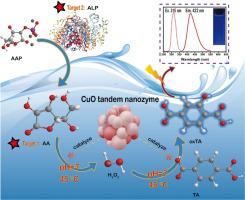Sensors and Actuators B: Chemical ( IF 8.4 ) Pub Date : 2020-06-25 , DOI: 10.1016/j.snb.2020.128511 Shao-Bin He , Paramasivam Balasubramanian , Ai-Ling Hu , Xiao-Qing Zheng , Meng-Ting Lin , Ming-Xuan Xiao , Hua-Ping Peng , Hao-Hua Deng , Wei Chen

|
During the past decades, most reported nanozymes have been confined to limited species of enzyme-like activities and only few examples were reported to mimic tandem enzyme-like activities. To fill gaps in expanding the species and improving catalytic efficiency of nanozymes, exploring nanozymes as tandem nanozymes has turned out to be an effective method. Herein, we have presented the cupric oxide nanoparticles (CuO NPs) as tandem nanozymes, which is expected to simultaneously catalyze the cascade reaction coupling ascorbate oxidase with peroxidase like activities at temperature (45 °C) and neutral pH (pH = 7). This one-pot cascade reaction system included the oxidation of ascorbic acid (AA) to yield H2O2 and terephthalic acid (TA) oxidation reaction mediated by H2O2 to generate a fluorescence product (λex = 315 nm, λem =422 nm). More significantly, fluorescent sensors are respectively fabricated for AA, alkaline phosphatase (ALP) and l-phenylalanine (ALP inhibitor) detection coupling the catalysis of CuO tandem nanozymes with ALP enzymatic reaction. Base on these findings, this work shows high selectivity/sensitivity and low limit of detection (2.92 × 10−8 M for AA, 0.058 U/L for ALP) properly due to an in-situ reaction. CuO tandem nanozymes expand the species of nanozymes and these CuO tandem nanozymes based fluorescent sensors can be applied for one-pot nonenzymatic biomolecular sensing in clinical diagnostics, biological or pharmaceutical analysis.
中文翻译:

CuO串联纳米酶驱动中性pH下的一锅级联催化抗坏血酸和碱性磷酸酶检测
在过去的几十年中,大多数报道的纳米酶仅限于酶样活性的有限种类,并且仅报道了模仿串联酶样活性的例子。为了填补扩大纳米酶的种类并提高纳米酶催化效率的空白,探索作为串联纳米酶的纳米酶已成为一种有效的方法。在这里,我们已经提出了氧化铜纳米颗粒(CuO NPs)作为串联纳米酶,它有望在温度(45°C)和中性pH(pH = 7)的同时催化抗坏血酸氧化酶与过氧化物酶的级联反应。这种一锅级联反应系统包括抗坏血酸(AA)的氧化以生成H 2 O 2和H 2介导的对苯二甲酸(TA)氧化反应O 2产生荧光产物(λex = 315 nm,λem = 422 nm)。更重要地,分别制造用于AA,碱性磷酸酶(ALP)和1-苯丙氨酸(ALP抑制剂)检测的荧光传感器,其将CuO串联纳米酶的催化与ALP酶促反应耦合。基于这些发现,由于原位反应,这项工作正确地显示了高选择性/灵敏度和低检测限(AA为2.92×10 -8 M,ALP为0.058 U / L)。CuO串联纳米酶扩展了纳米酶的种类,这些基于CuO串联纳米酶的荧光传感器可用于一锅非酶生物分子传感,用于临床诊断,生物学或药物分析。


























 京公网安备 11010802027423号
京公网安备 11010802027423号